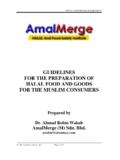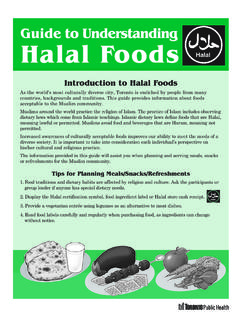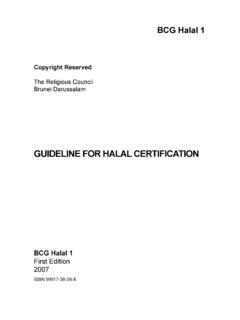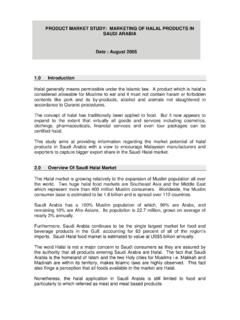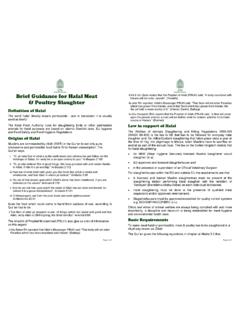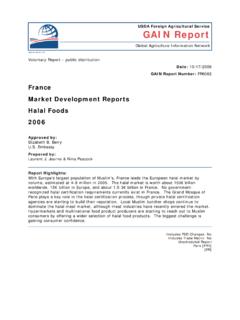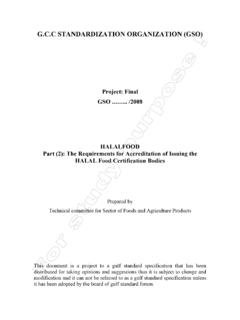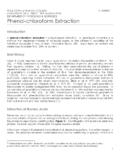Transcription of Improved DNA Extraction Method for Porcine …
1 Saudi Journal of Biological Sciences Vol. 15 No (2) December, 2008 225 Improved DNA Extraction Method for Porcine Contaminants, detection in imported Meat to The Saudi MarketIbrahim Abdullah AlaraidhBiology Department, Teachers College, King Saud University. P. O. 4341, Riyadh 11491, Saudi Arabia. E-mail: AbstractA Porcine detection methodology based on deoxyribonucleic acid (DNA) Extraction and polymerase chain reaction (PCR) amplification of a specific Porcine fragment was used in this paper. With the advent of mass globalization and the fast growing and rapidly changing halal industry of the international market it is of vital need that a practical scientific system be applied and established in the Kingdom of Saudi Arabia to detect and monitor the ingredients in food especially Porcine contaminants.
2 A simple modified technique was designed to extract DNA from food material. ASL buffer (Qiagen) for lysis and a series of incubation steps were applied prior to PCR and detection limits were established. The optimized Method was then used to identify pork in food products obtained from different local hypermarkets. The used Method was displayed to be robust and reliable. Out of thirty-three food samples labeled as halal, there were two imported samples; one beef steak and one beef sausage that were positive for Porcine contaminants. From the results it can be concluded that sufficient PCR ready DNA can be obtained by this single solution methodology. Although the incubation for the lyses is recommended to be overnight the cost of the experiment and the relative simplicity and reliability of the experiment allows a mass food testing ability and a viable commercialization opportunity in the Kingdom.
3 It is also of absolute importance that a systematic scientific precaution be taken to ensure that imported food products in Saudi Arabia are actually halal, as Allah says in the Holy Qur an: Forbidden to you (for food) are: Al-Maitah (the dead animals - cattle - beast not slaughtered), blood, the flesh of swine (S rat Al-M idah, Verse 3).Key Words: Porcine , DNA, PCR, Primer, Processed meat, detection , Journal of Biological Sciences 15 (2) 225-229 December 2008 ISSN 1319-562 XThe Official Journal of the Saudi Biological Society of meat products by mixing meats and fats of different origin is illegal. This kind of adulteration is a common procedure in most countries.
4 Adulteration with cheaper ambiguous meats or improper labeling of meat products as Halal while it contained pork or pork fat clearly interferes with the religious prohibitions for Muslims around the world. Permissible nature (Halal) of any product including food, accessories and relationships is of particular importance for Muslims, whether in moral or physical life, particularly in the current era of globalization, where a single processed food product could be subject to elements sourced from several nations with its origin doubted or neglected due to ignorance or lack of technology. Therefore, in the current era where free trade and mass market globalization is dominating, certain food producers take advantage of every opportunity to increase profits and neglect proper food safety protocols with respect to religious or cultural beliefs.
5 Hence, several studies are currently being carried out in the field of food detection systems. Especially with regard to pork in processed or non-processed food products, various methodologies that are equally effective and reliable in their relevant approaches are currently used for detection instance the detection of pork and lard as adulterants in processed beef and mutton mixtures is carried out where the mixture of derivative and saturated triglycerides is analyzed by liquid chromatography using a reverse-phase column and a UV detector. Pork fat has larger amounts of triglyceride containing saturated fatty acid at the C-2 position than does the fat of other meat.
6 The ratio of triglyceride containing saturated fatty acid vs. triglyceride containing unsaturated fatty acid at the same (C-2) position Saudi Journal of Biological Sciences Vol. 15 No (2) December, 2008226 Ibrahim Abdullah Alaraidh(SSU/SUS) in a sample is compared with those of pure meats. The presence of pork in the sample causes the ratio to increase compared with ratios for pure beef or mutton. The increase in the SSU/SUS ratio is significant for the addition of 1% pork in beef. In the case of mutton, the addition of 3% pork causes a noticeable change (Saeed, et al ., 1989). detection of pork by PCR amplification of nuclear 18S ribosomal RNA and growth hormone gene or Y chromosome has been previously described (Meyer et al.)
7 , 1995 and Meyer et al., 1994). In other methods , the use of fluorescence sensor capillary electrophoresis allows identification of specific DNA fingerprint species of pork, goat, and beef generated by restriction enzyme digestion using fluorescence labeling PCR amplification (Al-Rashood et al., 1995). Specific detection of processed pig and cattle materials treated at 134 degrees Celcius in various feed matrices down to a limit of detection of about was reported (Fumi re et al., 2006). The detection quantification of bovine, Porcine , lamb, chicken, turkey, and ostrich DNA in complex samples was achieved by using TaqMan real-time polymerase chain reaction (PCR) systems using minor groove binding (MGB) probes.
8 Species-specific amplification was achieved by combining only two fluorogenic probes and 10 oligonucleotide primers targeting mitochondrial sequences. The limits of detection ranged from to pg of template DNA. Analysis of experimental mixtures containing two to four different species showed the suitability of the assay for detection of more than 1% of pork, chicken, or turkey and of more than 5% of cattle or lamb. The quantification accuracy in samples containing 10-100% of beef or pork DNA was close to 90% (L pez-Andreo et al., 2005; Hunt, 1997; Janseen, et al., 1998; Montiel-Sosa, et al., 2000; and Partis, et al, 2000). In a latest research, 3 food samples (2 chocolates and one chicken nugget) were tested positive for containing the 152bp fragments of the Porcine leptin (Farouk, et al.)
9 , 2006).PCR based methodology, used in this publication where pig-specific primers were used to amplify a 152 bp fragment from the procaine leptin gene that is the homologues of murine obese, is a successful technique of identification. As it is PCR-based, it is the most convenient for critical samples in which DNA is largely degraded such as with processed food (Farouk, et al., 2006; Stratil, et al., 1997; Wintero, et al., 1990, and Wolf, et al., 1999).The main target of the work was to develop a fast, cheap and reliable molecular technique in foods and to check foods bearing Halal tags for Porcine contamination by a simple species-specific band identification of PCR products in the Saudi market.
10 Materials and MethodsMeat SamplesThirty-three samples of frozen meat (beef steaks, beef sausage, minced beef, beef roast, turkey sausage, chicken sausage, chicken nuggets and chicken balls) were purchased from nearby hypermarkets. DNA isolationFrozen meat was thawed and grinded. 30 milligrams of the grounded meat were transferred into ml Eppendorf tube. 200 l ASL buffer (Qiagen) was added into the individual tubes containing the sample material. The mixtures were vortexed for 5 minutes and incubated overnight for sufficient lysis to maximize DNA Extraction . After incubation the samples were vortexed for 2 minutes and centrifuged at full speed (13,000 rpm) for 15 minutes using the Biofuge Pico, Germany to remove any solid particles.
